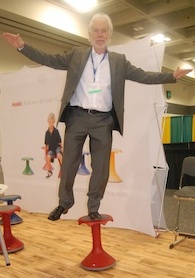Kids Fidget and Rock While Learning More
 SAN FRANCISCO — When we think about learning and ergonomics in the classroom, we may not be picturing kids rocking on their chairs, or sitting backwards on them, but those movements are precisely what is needed to facilitate learning, sustain concentration and maintain healthy posture, according to Dieter Breithecker, a health and kinetics scientist, and head of the Federal Institute on the Development of Posture and Exercise in Germany, who was at the VS America booth at NSBA.
SAN FRANCISCO — When we think about learning and ergonomics in the classroom, we may not be picturing kids rocking on their chairs, or sitting backwards on them, but those movements are precisely what is needed to facilitate learning, sustain concentration and maintain healthy posture, according to Dieter Breithecker, a health and kinetics scientist, and head of the Federal Institute on the Development of Posture and Exercise in Germany, who was at the VS America booth at NSBA.
“For mental and physical surviving, it is crucial that kids in elementary school are fidgety and rock,” Breithecker said. “It is important for their health, attention and concentration. It means they have more overall oxygen supply, higher temperature and more oxygen in their brain.”
In an interview at the National School Board Association show, Breithecker explained how hip rotations, on a chair deigned by VS America, can cause the brain to activate neurotrophins, resulting in better concentration.
The PantoMove chair, with a 3D rocking mechanism and concave base, allows students to move their hips in patterns: sideways, swivel, and forward and back. Breithecker emphasized the need to eliminate rigid furniture. He said the mechanics of chairs must allow for children’s bodies to be in motion whereby the blood flow is facilitated by the interdependency between movement and brain activity.
Dynamic sitting provides students flexibility needed to expend energy and, at the same time, to focus on their work instead of having to focus on how to keep still, according to VS, a company whose history dates back to 1898, when it was formed by the amalgamation of four school-furniture manufacturers.
In 1945, major changes after WWII impacted school furniture design as the rigid school bench was pushed into the background and more flexible seating options were sought after. Since then, the trend shows less movement in the classroom increasing significantly. Since 1940, the hours per day students sit has grown, from five up to 10, while the number of hours spent moving has dropped from just near seven hours to less than one hour a day, according to Breithecker.
